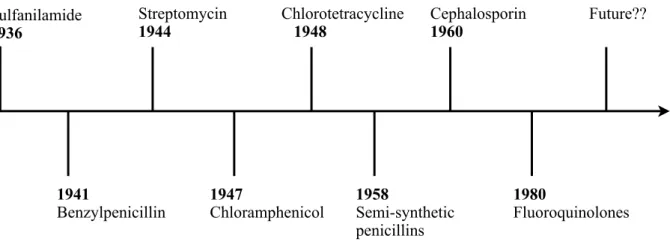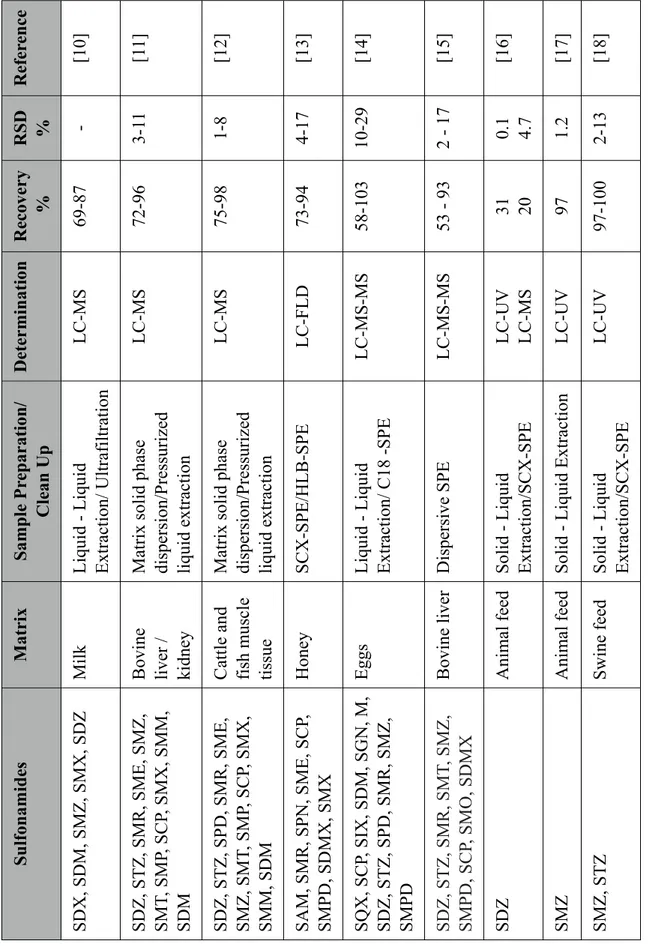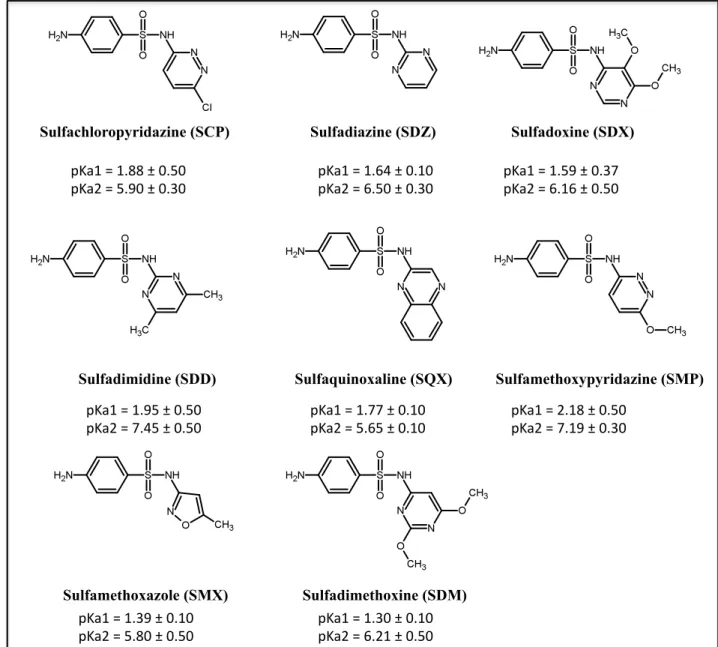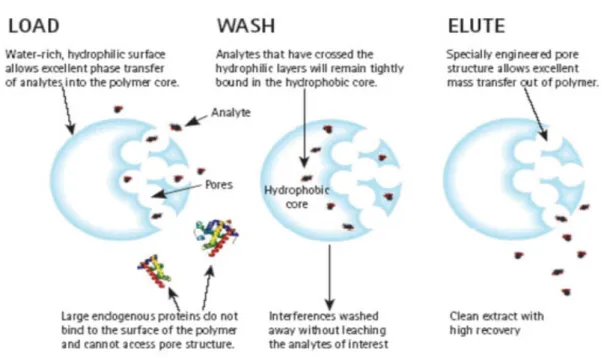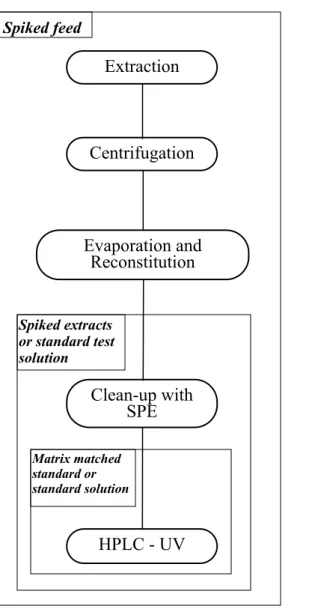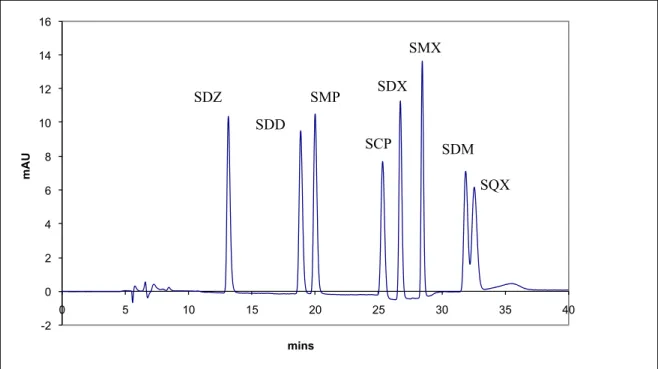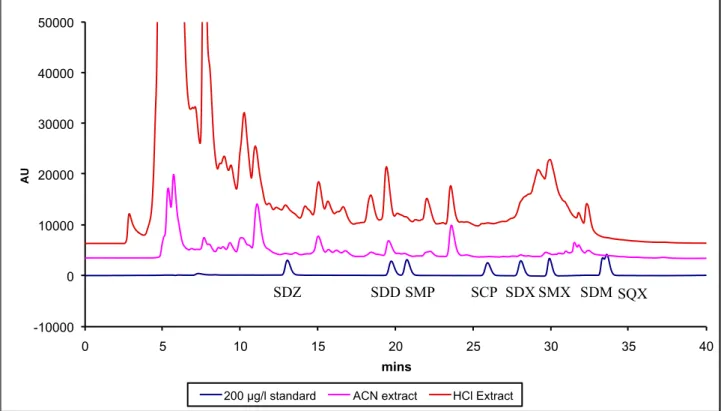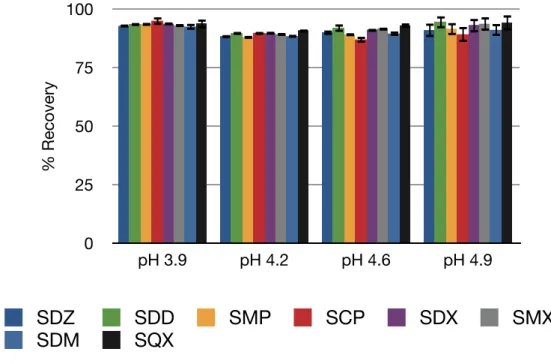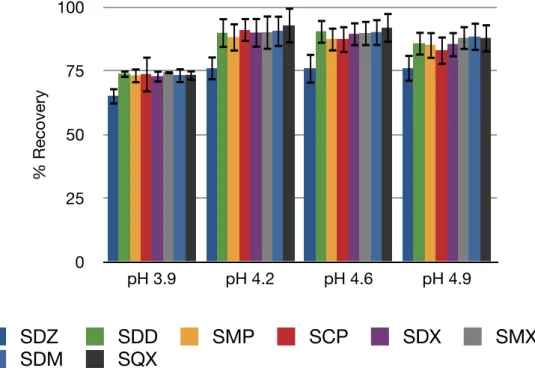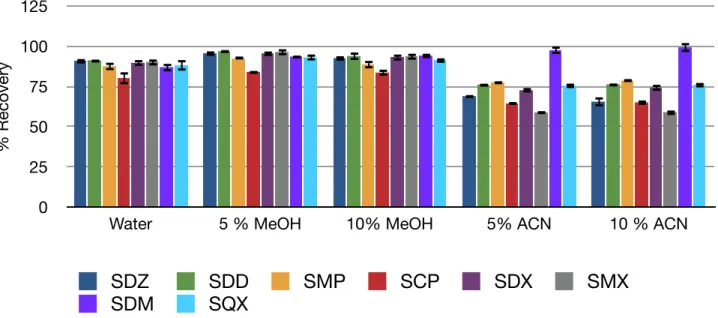Optimization of an SPE Clean-up Approach
for the Analysis of Sulfonamides in
Animal Feed
Master’s Thesis
Department of Analytical Chemistry University of Barcelona
2010
Dr. Ramon Companyó, Professor of Department of Analytical Chemistry at University of Barcelona,
ATTESTS
The current work titled
“Optimization of an SPE Clean-up Approach for the Analysis of
Sulfonamides in Animal Feed”
has been conducted by Praveen Kumar Kumar in the Department of Analytical Chemistry at University of Barcelona under my supervision
Barcelona, February 2010
_______________________ Dr. Ramon Companyó
Acknowledgement
My heartfelt thanks to Dr. Ramon Companyó, my supervisor for his constant guidance and encouragement in my research efforts, without which I could not have completed this work in a short time.
I express my gratitude and appreciation to other members of my research team - Silvia (‘Teacher’) and Vanesa (‘Scientific adviser’) for their patience in clearing my ‘cosas’ and helping me to get adapted in Fluroescence research group. I would also like to appreciate Joana (‘Special’) for her bubbling and energetic company during these project days.
Next, my housemates - Glauce and Leo, who made me feel home away from my home and made my stay in Barcelona much more enjoyable.
A special thanks goes to EMQAL and it organisers for making me rich with friends from all parts of the globe (which I never imagined) and making this part of my life a special one.
My hearty gratitude to many people, not mentioned here (a big but important list), whom I met during these EMQAL days, whose presence ‘behind-the-screen’ makes me moving up in my professional and personal life.
Last but not the least, I ‘acknowledge’ my parents awaiting my return home, for their attitude and encouragement to send me across the seas and watch me with a unique care and emotional support.
Abstract
1List of Acronyms
51. Introduction
91.1. Antibiotics 11
1.2. Use of antibiotics 12
1.3. Antibiotic residues and veterinary feedstuff 12
1.4. Antibiotic resistance 13
1.5. Legislations and Regulations 14
1.6. Sulfonamides 14
1.7. Conventional Analytical methodologies 17
1.8. Solid Phase Extraction 17
1.8.1. Bond Elut C18 cartridges 17
1.8.2. Oasis HLB 18
1.8.3. Bond Elut Plexa 18
1.8.4. Bond Elut Plexa PCX 18
1.9. Dispersive SPE 19
2. Experimental Part
212.1. Chemicals and reagents 23
2.1.1. Sulfonamides 23
2.1.2. Extracting solutions 23
2.1.3. Solutions for SPE 24
2.1.4. Mobile Phase 24
2.2. Instrumentation 24
2.3. Pig rearing feed 26
2.4. Analytical Methodology 26
2.4.2. Preparation of Matrix Matched standards 26
2.4.4. Preparation of Spiked feed 28
2.4.5. Quantification 28
2.4.6. Liquid Chromatography with UV Detection 29
3. Results and Discussion
313.1. Optimization of SPE with C18, Oasis HLB and Plexa 33
3.1.1. Extraction 33
3.1.2. Selection of pH for sample solution 34 3.1.3. Selection of washing solvents and washing steps 36 3.2. Optimization of SPE parameters with Plexa PCX 43
3.2.1. Washing solution 43
3.2.3. Extraction strategies 46
3.3. Comparison of Oasis HLB and Plexa PCX 47
3.4. Dispersive SPE 50
4. Conclusions
51In this work, clean up strategy is optimized for an analytical method based on liquid chromatography with UV detection for determination of eight sulfonamides (sulfachloropyridazine, sulfadiazine, sulfadimidine, sulfadoxine, sulfamethoxypyridazine, sulfaquinoxaline, sulfamethoxazole and sulfadimethoxine) in pig feed. Solid Phase Extraction is used for clean up and the performance of different sorbents - C 18, Oasis HLB, Plexa and Plexa PCX is assessed by their clean up efficiency and recovery of analytes. Oasis HLB and Plexa PCX sorbents provide better clean up and recovery values than C18 and Plexa. A spiked feed of 2 mg/kg is used to assess mean recoveries and precision in terms of repeatability, r and within-lab reproducibility, R for the whole method with Oasis HLB and Plexa PCX. Recoveries using Oasis HLB ranges from 51 to 78%, with RSDr from 5 to 15% and RSDR from 5 to 18%. Recoveries using Plexa PCX ranges from 64 to 85% with RSDr from 4 to 11% and RSDR from 7 to 17%.
ACN Acetonitrile
ASFAC Associacio Catalana de Fabricants de Pinsos d-SPE Dispersive Solid Phase Extraction
ECDC European Center for Disease prevention and Control EFSA European Food Safety Authority
EMA European Medicines Agency
FEDESA European Federation of Animal Health HLB Hydrophilic-Lipophilic Balance
HPLC High Performance Liquid Chromatography
MeOH Methanol
MRL Maximum Residue Limit
MRPL Minimum Required Performance Limit
PCX Polymeric Cation exchange
PSA Primary Secondary Amine
PVC Polyvinylchlorides
QuEChERS Quick, Easy, Cheap, Effective, Rugged and Safe RSD Relative Standard Deviation
RSDr Repeatability relative standard deviation
RSDR With-in lab reproducibility relative standard deviation
SCP Sulfachloropyridazine SDD Sulfadimidine SDM Sulfadimethoxine SDMX Sulfadimethoxine SDX Sulfadoxine SDZ Sulfadiazine SGN Sulfaguanidine SIX Sulfisoxazole SME Sulfameter SMM Sulfamonomethoxine SMO Sulfamoxole SMP Sulfamethoxypyridazine SMPD Sulfamethoxypyridazine SMR Sulfamerazine SMT Sulfamethiozole SMX Sulfamethoxazole SMZ Sulfamethazine
SPE Solid Phase Extraction
SPN Sulfapyridine
SQX Sulfaquinoxaline
STZ Sulfathiazole
UV Ultra-violet
WHO World Health Organization
1.1. Antibiotics
Antibiotics or antimicrobial drugs are the drugs that fight infections caused by bacteria or other microbes. In 1927, Alexander Fleming discovered the first antibiotic, penicillin. The term "antibiotic" originally referred to natural compounds produced by a fungus or other microorganisms that kills disease causing bacteria. Some of the natural antibiotics are benzyl penicillin, streptomycin, chloramphenicol, tetracyclines and macrolides. Semi-synthetic antibiotics are derivatives of natural antibiotics, obtained by small alterations in structural formulas of natural antibiotics e.g. naficillin and cloxacillin. Currently, the term antibiotic is also used for synthetic substances such as sulfonamides, nitrofurans and quinolones.
Sulfanilamide
1936
Streptomycin
1944 Chlorotetracycline 1948 Cephalosporin1960 Future??
1941
Benzylpenicillin 1947Chloramphenicol 1958Semi-synthetic penicillins
1980
Fluoroquinolones
Figure 1. Illustrates the timeline of the antibiotics. Entry of a new antibiotic drug into marketplace involves huge amount of research, money and many years of clinical phase trials. Antimicrobial resistance emerges and spreads so fast that the new antibiotics become useless very soon. Antimicrobial resistance seriously threatens future of the antibiotics and its use to humankind. There are several classification schemes for antibiotics, based on bacterial spectrum (broad, narrow), route of administration (injectable, oral, topical), type of activity (bactericidal, bacteriostatic) or chemical structure. The most useful classification system, based on the chemical structures is as follows
Figure 1. Timeline of antibiotics
• ! lactam antibiotics • Tetracyclines • Macrolides • Aminoglycosides • Amphenicols • Quinolones • Nitrofurans • Sulfonamides • Peptide antibiotics
Each class is composed of many drugs having similar structures.
1.2. Use of antibiotics
In addition to the use of antibiotics for human health, a large amount of them are used as prophylactic and therapeutic agents in livestock farming. Also, antibiotics were used as feed additives for growth promotion until 2006. In EU, all the antibiotics except some coccidiostats and histomonostats are prohibited to be used as feed additives since 2006 [1]. According to a study by the European Federation of Animal Health (FEDESA), in 1999, 4700 tonnes (35%) of all the antibiotics administered in the European Union were consumed by farm animals, while 8500 tonnes (65%) are consumed by humans. Of all the antibiotics given to animals, 3900 tonnes (or 29% of the total usage) are administered to treat diseases, while 786 tonnes (or 6% of the total usage) are given to farm animals in their feed as growth promoters [2]. According to WHO, in North America, an estimated 50% in tonnage of all antimicrobial production are used in food-producing animals and poultry [3].
1.3. Antibiotic residues and veterinary feedstuff
Anitibiotic residues are the traces of antibiotics or their derivatives which can be found in food products of animal origin, veterinary feedstuff, soils, manure, surface waters and waste waters due to the extensive use of antibiotics by human.
The presence of antibiotic residues in animal food products is mainly due to the widespread use of antibiotics in livestock farming. Another important reason, is the cross contamination of unmedicated feedstuff. Antibiotics for prophylactic or therapeutic purpose are generally administered in-feed as medicated feed for intensively reared species e.g. poultry and pigs. In feed mills, after the preparation of medicated feed, it is common to produce unmedicated feed in the same production line [4]. Residual quantities of medicated feed may be retained at various points along the production line, contaminating subsequent batches of unmedicated feed, as they are processed, resulting in carryover of the residues to unmedicated feed. Other sources of contamination include cross contamination in trucks used to deliver both medicated and unmedicated feed and inadequate purging of feeding systems when medicated feeds are replaced with unmedicated feeds. Such low level contaminations in the feedstuff are sufficient to cause residues in meat, eggs or milk from animals which are fed with the contaminated feed [5]. This raises the concern to control the unwanted presence of antibiotic residues in veterinary feed.
1.4. Antibiotic resistance
Antibiotic resistance is the ability of bacteria or other microbes to resist the effects of an antibiotic. Antibiotic resistance occurs when bacteria change in a way that reduces or eliminates the effectiveness of drugs, chemicals, or other agents designed to cure or prevent infections. The bacteria survive and continue to multiply causing more harm.
The antibiotic resistance occurs whenever antibiotics are used. Every time a person takes antibiotics, sensitive bacteria are killed, but resistant germs may be left to grow and multiply. Repeated and improper uses of antibiotics are primary causes of the increase in drug resistant bacteria. According to a report recently released by European Centre for Disease Prevention and control (ECDC) and European Medicines Agency (EMA), each year 25,000 patients die in the EU from infections caused by resistant microorganisms with extra healthcare costs and productivity losses of at least 1.5 billion " per year [6]. Antibiotic resistance is a continually evolving and serious problem that if not prevented, could lead to a global health crisis.
The use of antibiotics in animal feed is one of the important factors for spreading the antibiotic resistance. The desired and undesired exposure of farm animals to antibiotics as antibiotic residues in feedstuff result in increase of resistance in bacteria (such as Salmonella and Campylobacter) that can spread from animals, often through food, to cause infections in human [3].
1.5. Legislations and Regulations
In EU, a number of legislations and regulations have been laid to ensure food and feed safety. Also, EU has set up European Food Safety Authority (EFSA) as an independent scientific body to assess and communicate risks, and to provide scientific advice regarding food and feed safety. Companyo
et. al., [7] provides a summary of legislations and regulations concerned with control of veterinary
drug residues in foodstuffs of animal origin. Some of the important legislations are briefed here.
Regulation (EC) No 178/2002 lays down the general principles and requirements of food law,
establishes the EFSA and procedures regarding food safety.
Directive 90/167/EEC lays down the conditions governing the preparation, placing on the market
and use of medicated feedstuffs in the Community.
Regulation (EC) No 1831/2003 controls the use of additives for animal nutrition. Regulation (EC) No 183/2005 lays down the requirements for feed hygiene.
Decision 2002/657/EC implements Council Directive 96/23/EC concerning the performance of
analytical methods and the interpretation of results.
Decision 2004/25/EC amends Decision 2002/657/EC which sets the minimum required
performance limits (MRPLs) for certain residues in food of animal origin.
1.6. Sulfonamides
Sulfonamides form a diverse class of synthetic antibiotics with chemically related compounds, having a functional group –S (=O)2NH2 . The general chemical structure of sulfonamides is given in the figure 2. Sulfonamides are hydrophilic in nature, making it difficult for selective extraction from the matrix. The structure of sulfonamides and their estimated values of dissociation constants studied in this work are as shown in the figure 3.
Figure 2. General structure of Sulfonamides.
15 Ta bl e 1.S el ec te d m et hods for t he a na lys is of s ul fona m ide s * F or a cronym s, re fe r L is t of A cronym s S u lfon ami d es M atr ix S amp le P re p ar ati on / C le an U p D ete rmi n ati on R ec ove ry % RSD % R efe re n ce S D X , S D M , S M Z , S M X , S D Z Milk L iqui d - L iqui d E xt ra ct ion/ U lt ra fi lt ra ti on L C-M S 69-87 -[10] S D Z , S T Z , S M R, S M E , S M Z , S M T, S M P, S CP , S M X , S M M , SDM Bovi ne li ve r / ki dne y M at ri x s ol id pha se di spe rs ion/ P re ss uri ze d li qui d e xt ra ct ion L C-M S 72-96 3-1 1 [1 1] S D Z , S T Z , S P D , S M R, S M E , S M Z , S M T, S M P, S CP , S M X , S M M , S D M Ca tt le a nd fi sh m us cl e ti ss ue M at ri x s ol id pha se di spe rs ion/ P re ss uri ze d li qui d e xt ra ct ion L C-M S 75-98 1-8 [12] S A M , S M R, S P N , S M E , S CP , S M P D , S D M X , S M X H one y S CX -S P E /H L B-S P E L C-F L D 73-94 4-17 [13] S Q X , S CP , S IX , S D M , S G N , M , S D Z , S T Z , S P D , S M R, S M Z , SMPD E ggs L iqui d - L iqui d E xt ra ct ion/ C18 -S P E L C-M S -M S 58-103 10-29 [14] S D Z , S T Z , S M R, S M T, S M Z , S M P D , S CP , S M O , S D M X Bovi ne li ve r D is pe rs ive S P E L C-M S -M S 53 - 93 2 - 17 [15] SDZ A ni m al fe ed S ol id - L iqui d E xt ra ct ion/ S CX -S P E L C-U V L C-M S 31 20 0.1 4.7 [16] SMZ A ni m al fe ed S ol id - L iqui d E xt ra ct ion L C-U V 97 1.2 [17] S M Z , S T Z S w ine fe ed S ol id - L iqui d E xt ra ct ion/ S CX -S P E L C-U V 97-100 2-13 [18]
Sulfadiazine (SDZ) Sulfadimidine (SDD) Sulfachloropyridazine (SCP) Sulfadimethoxine (SDM) Sulfadoxine (SDX) Sulfamethoxazole (SMX) Sulfamethoxypyridazine (SMP) Sulfaquinoxaline (SQX) !"#$%&%$'((%)%*'+*%%
!"#,%&%+'-*%)%*'.*% !"#$%&%$'/0%)%*'$*%%!"#,%&%/'+*%)%*'.*% !"#$%&%$'+-%)%*'.1%%!"#,%&%/'$/%)%*'+*%
!"#$%&%$'-+%)%*'+*%%
!"#,%&%1'0+%)%*'+*% !"#$%&%$'11%)%*'$*%%!"#,%&%+'/+%)%*'$*% !"#$%&%,'$(%)%*'+*%%!"#,%&%1'$-%)%*'.*%
!"#$%&%$'.-%)%*'$*%%
!"#,%&%+'(*%)%*'+*% !"#$%&%$'.*%)%*'$*%%!"#,%&%/',$%)%*'+*%
Sulfonamides are used in agriculture, aquaculture, animal husbandry, and rarely in human medicine. As said before, sulfonamides as antibiotics, are banned to be used as growth promoters, but used in medicated feeds. Their use in medicated feed provides the possibilities of contaminating unmedicated feed and the sulfonamides are considered to be one of the most common contaminating antibiotics in animal feed. The presence of sulfonamide residues in food is of concern because of its possibility of developing antibiotic resistance and moreover because of its potential carcinogenic nature in humans [8]. Currently maximum levels for sulfonamides in veterinary feed has not been established, but community MRL for all sulfonamides in foodstuffs of animal origin is 100 #g/kg [9]. The inclusion rates for sulfonamides in medicated feedstuff ranges from 73 to 812 mg/kg for pig rations [4]. In unmedicated feedstuff, a zero tolerance level is desired.
Figure 3. Structure of sulfonamides studied and their dissociation constant values.
1.7. Conventional Analytical methodologies
Though many analytical methods are being developed for analysis of sulfonamides in foodstuff, there are only very few analytical methods for the analysis of sulfonamides in veterinary feed. This is primarily due to the lack of legislations over the use of antibiotics in animal feedstuff until recently. In analytical perspective, the feed is a very complex matrix and its composition differ for each kind of animal feed and for each production batch. So, each sample of feed has its own characteristics and the interfering compounds vary for each sample which makes it difficult to develop a robust method. Some of the selected methods illustrating different sample preparation/ clean-up procedures for analysis of sulfonamides in food and feed matrices are shown in the table1.
1.8. Solid Phase Extraction
SPE (Solid Phase Extraction) is a popular sample preparation method, which has evolved in many formats and different phases of sorbents in the last few decades. Disposable cartridges for SPE are being used for more than 20 years – first cartridges in 1978, syringe format types in 1979, precolumns for the online coupling with liquid chromatography in early 1980s. The need to decrease the use of organic solvent usage in laboratories has encouraged the requirement for solvent free procedures, which in turn increased the growth of SPE [19]. Moreover, SPE allows more possibilities to tailor the conditions such as choice of sorbent and solvent, washing and eluting solutions and number of wash steps depending on the analyte-matrix pair, to achieve maximum recovery and minimum interferences.
A desirable factor while developing a method using SPE is to decrease the number of steps to obtain extracts free from matrix interference, thereby decreasing the risk of sample contamination. C18, Oasis HLB, Plexa and Plexa PCX are the sorbents used in this study.
1.8.1. Bond Elut C18 cartridges
C18 is a hydrophobic silica-based sorbent, and the most popular SPE sorbent because of its extreme retentive nature for non-polar compounds. C18 is the least selective silica based sorbent which is advantageous when analytes varying widely in structure has to be analyzed. The polar interactions between analytes and sorbent is less because of the long hydrocarbon chain.
1.8.2. Oasis HLB
Oasis HLB contains a polymeric sorbent with Hydrophilic-Lipophilic Balance (HLB) property, designed to extract acidic, basic and neutral compounds using simplified procedures
1.8.3. Bond Elut Plexa
Plexa is a restricted access packing combining size-exclusion and reversed phase mechanisms. It is designed primarily for biological samples, since it prevent the access of matrix components like proteins while retaining analytes in the interior of the sorbent (Figure 4). Plexa is suitable for acidic, basic and neutral analytes.
1.8.4. Bond Elut Plexa PCX
Plexa PCX is a mixed-mode ion exchanger with hydrophobic and strong cation exchange sites, which concentrates basic analytes and removes neutral and acidic interferences.
courtesy : varianinc.com
Figure 4. Illustrating the behavior of Plexa sorbent
1.9. Dispersive SPE
QuEChERS standing for “quick, easy, cheap, effective, rugged, and safe” is a commercially available approach involving extraction in a centrifuge tube between a minimal amount of acetonitrile solvent and sample containing water using magnesium sulfate followed by dispersive solid-phase extraction (d-SPE) for cleanup. The original QuEChERS method was first introduced by Anastassiades and Lehotay in 2003 [20], for determination of pesticide residues and it is proved to be an efficient and simple-to-use clean up procedure. Since then, QuEChERS concepts are evolving and used for pesticide analysis in different food matrices like olives[21], barley[22] , different fruits and vegetables [23] and also for other analytes like drug residues [24] and acrylamide in various food matrices [25] .
In this scenario, the objective of this work is to choose a right sorbent for SPE among C18, Oasis HLB, Plexa and Plexa PCX and optimize a clean up strategy for analyzing the eight sulfonamides (sulfachloropyridazine, sulfadiazine, sulfadimidine, sulfadoxine, sulfamethoxypyridazine, sulfaquinoxaline, sulfamethoxazole and sulfadimethoxine) in pig feed sample.
2.1. Chemicals and reagents
2.1.1. SulfonamidesSulfadiazine (SDZ) VETRANAL, Riedel-de-Haen, 99.6% Sulfadimidine (SDD) VETRANAL, Riedel-de-Haen, 99.9 % Sulfamethoxazole (SMX) VETRANAL, Riedel-de-Haen, 99.9% Sulfachloropyridazine (SCP) VETRANAL, Riedel-de-Haen, 98.8 % Sulfadoxin (SDX) VETRANAL, Riedel-de-Haen, 99.9%
Sulfadimethoxin (SDM) VETRANAL, Riedel-de-Haen, 99.9% Sulfaquinoxaline (SQX) VETRANAL, Riedel-de-Haen, 98.5%
Sulfamethoxypyridazine (SMP) VETRANAL, Riedel-de-Haen, 99.2%
A single stock solution of sulfonamides with a concentration of 50 mg/l for each sulfonamide is prepared from solid sulfonamide standards, in methanol (Liquid chromatography grade, Merck). The solutions are prepared in amber glass vials and stored in the refrigerator at 4°C. The standard test solutions of lower concentrations for optimizing SPE are prepared from the stock solution, by serial dilution with a buffer or acidic solution depending on the kind of sorbent. The standard solutions for quantification are prepared in mobile phase.
2.1.2. Extracting solutions
4% Phosphoric acid - 4 ml of concentrated phosphoric acid (85%, Panreac Quimica SAU) to 100 ml of water (18.2 M$cm-1, Millipore )
0.05 M HCl solution and 0.2 M HCl solution prepared from concentrated hydrochloric acid ( 37%), Analytical grade, Merck.
Acetonitrile ( 5% water) - 5 ml of water (18.2 M$cm-1, Millipore ) to 100 ml of acetonitrile liquid chromatography grade (99.9%), Panreac Quimica SAU
2.1.3. Solutions for SPE
0.01 M formic acid buffer (pH 3.9) - prepared with formic acid ( 98 - 100%, Analytical grade, Merck) and pH adjusted to 4.9 with 1M sodium hydroxide (Merck)
0.01M acetic acid buffer (pH 4.2, pH 4.6 and pH 4.9) - prepared with acetic acid (99.9%, J.T. Baker) and pH adjusted with 1M sodium hydroxide (Merck) to make three different solutions of pH 4.2, pH 4.6 and pH 4.9.acid 99-100%, J.T. Baker)
Methanol, liquid chromatography grade, Merck
Acetonitrile, liquid chromatography grade (99.9%), Panreac Quimica SAU Formic acid , analytical grade (98-100%), Merck.
0.5% ammonia in MeOH:ACN (1:1)- 400 #l of 25% ammonia solution ( analytical grade , Merck) to 20 ml of MeOH:ACN (1:1) mixture.
0.5% ammonia in ACN - 400 #l of 25% ammonia solution ( analytical grade , Merck) to 20 ml of acetonitrile.
2.1.4. Mobile Phase
0.01 M Acetic acid/acetate buffer – Acetic acid is dissolved in water (Millipore-18$m) and pH is adjusted to 4.7 with 0.3M NaOH. The buffer solution is filtered through a 0.45 #m nylon membrane before using for chromatographic separation.
Acetonitrile, liquid chromatography grade (99.9%), Panreac Quimica SAU
2.2. Instrumentation
pH meter – Crison – GLP 21 with a precision of 0.01 pH units and a sensor of combined glass and
Ag/AgCl reference electrode (Crison 5202).
Centrifuge – Heraeus Labofuge 400 with a range of 600 to 6000 rpm.
Evaporator - TurboVap® LV Evaporator Workstation by Caliper Lifesciences has a capability to
evaporate upto 50 samples with interchangeable tube racks for volume sizes ranging from 1.5 ml to 30 ml. The time for evaporation and water bath temperature can be set in the microprocessor control. The water bath temperature is adjustable from ambient to 99°C. The evaporation is aided and accelerated by nitrogen gas vortex.
Vortex mixer – Stuart SAB with a range of 200 - 2500 rpm.
Rapid Trace® SPE Workstation - Rapid trace SPE Workstation, by Caliper Lifesciences is an
automated Solid Phase Extraction platform. The system supports 1 ml and 3 ml SPE cartridges. A sequence of samples can be set to run in series and for each sample different methods can be assigned. The sample and solvents are loaded onto the cartridge by positive pressure.
SPE cartridges used are listed in table 2,
Type Volume of
cartridge
Amount of sorbent
Bond Elut C18, Varian 1 ml 100 mg
Bond Elut Plexa, Varian 3 ml 60 mg
Bond Elut Plexa PCX, Varian 3 ml 60 mg
Oasis HLB, Waters 3 ml 60 mg
QuEChERS - DisQue - Dispersive SPE kit by Waters containing,
DisQuE Extraction (Tube 1): A 50 ml centrifuge tube containing 1.5 g anhydrous sodium acetate and 6 g of anhydrous magnesium sulphate.
DisQuE Clean-Up (Tube 2): A 2 ml centrifuge tube containing 150 mg anhydrous magnesium sulphate and 50 mg of primary secondary amine (PSA) sorbent.
Liquid chromatography with UV detection
The compounds studied in this work are determined using an Agilent 1100 series liquid chromatography instrument, consisting of the following components.
Degasser with a vacuum system to degasify solvents.
Quaternary pump, allows working with a gradient mobile phase composition with flow rate ranging from 1#l/min to 10 ml/min. Each channel can allow 0 to 100% of solvent with increments of 0.01%.
Table 2. List of SPE cartridges used.
Automatic liquid sampler, with a capacity to place 100 vials of 2 ml volume, allows to run sequence of large number of samples. The standard injection volumes are between 0.1 and 100 #l and RSD of peak areas is less than 0.5% for injection volumes between 5 and 100 #l.
Chromatographic Column - a reverse phase, C 8 Intersil column of GL Sciences Inc. with a length of 250 mm and diameter of 4.6 mm is used. A precolumn, matching with the characteristics of the column and with dimensions of 7.5x4.6 mm is used.
Diode Array Detector, with deuterium and tungsten lamps as light sources with a wavelength range of 190 to 950 nm, covering UV, visible and infrared region. The slit is programmable between 1 to 16 nm providing rapid optimization of sensitivity, linearity and spectral resolution. 1024 photodiodes are present.
2.3. Pig rearing feed
Pig-rearing feeds are supplied by the Associacio Catalana de Fabricants de Pinsos (ASFAC). They are stored at 4° C in polyvinylchloride (PVC) flasks.
2.4. Analytical Methodology
A general scheme of the analytical methodology and the parameters optimized in this work, are shown in figure 5, illustrating the use of standard test solutions, spiked feed and spiked extracts for optimizing different steps of the method. The conditions for centrifugation, evaporation and HPLC UV were optimized during other studies done in the research group.
2.4.2. Preparation of Matrix Matched standards
Matrix matched standards are the standards prepared in blank matrix to avoid the bias due to matrix mismatch between test materials and calibration set.
Matrix matched standards are prepared for quantification when spiked extracts or spiked samples are analyzed. For a 500 #g/l standard, After SPE, 0.85 ml eluate of blank matrix is taken in a 5 ml volumetric flask. 500 #l of 5 mg/l standard is added to the flask and made upto 5 ml with pH 4.7 buffer. The solution is then filtered with 0.45 #m nylon filter into injection vials.
2.4.3. Preparation of Spiked extracts
Spiked extracts are used to evaluate the clean up and recovery efficiency of SPE considering the uncertainties of SPE and HPLC (Figure 5). Blank feed is extracted with a solvent or acidic solution. After evaporation and reconstitution of extract, standards of known concentration are spiked to the extract.
Method A - When Evaporation step is not required in the procedure - For the preparation of a spiked extract of 500 #g/l concentration, 500 #l of 5 mg/l standard solution is added in a volumetric flask
Extracting solvents - Organic solvents or acidic solutions
Possibilities of avoiding evaporation step
• pH of the sample solution • Sorbent (C18, Oasis HLB,
Plexa , Plexa PCX) • Washing solvents &
washing steps • Eluting solvents Centrifugation Clean-up with SPE Evaporation and Reconstitution HPLC - UV Extraction 27 Spiked feed Spiked extracts or standard test solution Matrix matched standard or standard solution
General scheme of the methodology Parameters optimized in this study
Figure 5. Illustrating the use of spiked feed, spiked extracts and standard solutions for optimization of the method
and made up to 5 ml with extract from the blank feed. 5 mg/l standard solution is prepared from the stock standard solution.
Method B - When evaporation step is required in the procedure - blank feed is extracted with a solvent, centrifuged at 3500 rpm for 10 mins and evaporated in the Turbovap Evaporator at 50 °C For the preparation of a spiked extract of 500 #g/l, the evaporated extract is reconstituted with 500 #g/l standard solution prepared in buffer or acidic solution depending on the SPE cartridge used.
2.4.4. Preparation of Spiked feed
A spiked pig feed of 2 mg/kg concentration, prepared by another student in the laboratory is used for analyzing the recovery of the whole method considering uncertainty of the all the steps in the methodology (Figure 5).
Spiked feed is prepared by mixing blank feed with solid sulfonamide standards. Initially, a 500 mg/kg material is prepared by adding 62.5 mg of each sulfonamide with 125 g of the feed. The mixture is then filled in a PVC flask containing teflon balls and rolled on a rolling table for atleast 90 h. Homogeneity of the material is checked by taking samples from different parts of the material and determining the concentration of the sulfonamides by liquid chromatography with ultraviolet detection. After checking the homogeneity, 10 g of the material is taken and diluted with 90 g of blank feed to get 50 mg/kg material. Homogenization and homogeneity checking are performed as described before. Subsequently, 4 g of 50 mg/kgmaterial is taken and diluted with 96 g of blank feed to prepare a spiked feed of 2 mg/kg. After homogenization and checking homogeneity, the spiked feed is stored in a refrigerator at 4° C.
2.4.5. Quantification
A reference standard of known concentration is chromatographed separately from the sample and the results from both the chromatograms are compared for quantification of the analytes. The concentration of the analyte in the sample, Cs is given by
where,
As is the area of the peak of the analyte in the sample solution
Ar is the area of the peak of the analyte in the standard solution Cr is the concentration of the analyte in the reference standard
The reference standard is a standard solution or matrix matched standard, and the sample solution is a standard test solution or spiked sample respectively.
For analyzing spiked feed of 2 mg/kg concentration, matrix matched standards of three different concentrations near the expected concentration in the sample are prepared. A calibration curve is plotted and the concentration of the analytes in the sample solution is found by interpolation.
2.4.6. Liquid Chromatography with UV Detection
A mixture of acetonitrile and 0.01 M aqueous acetic acid - sodium acetate buffer (pH 4.7) is used as mobile phase. The mobile phase solutions are prepared everyday and filtered before using for LC-UV. The conditions used for analyzing sulfonamides are as follows,
Type of elution - Gradient Elution (table 3) with mobile phase constituting acetonitrile and the buffer.
Mobile phase flow rate - 0.6 ml/min. Sample Volume injected - 50 #l/min.
Wavelength of the Diode array detector - 268 nm.
Time (mins) % ACN
0 17
15 25
20 40
25 17
35 17
The separation of the sulfonamides and their retention order are shown in the figure 6. The Limit of Detection (LOD), Limit of Quantification (LOQ) and precision in terms of repeatability and
within-Table 3. Gradient elution steps
lab reproducibility conditions of this method were determined by another student in the research group [26] and are given in table 4.
Sulfonamides LOD µg/l LOQ µg/l Precision Precision Precision Precision Sulfonamides LOD µg/l LOQ µg/l 200 µg/l200 µg/l 600 µg/l600 µg/l Sulfonamides LOD µg/l LOQ µg/l RSDr % RSDR% RSDr % RSDR% SDZ 12 4 3.5 6 2.3 4.1 SDD 14 4 3.6 6.8 2.4 3.9 SMP 13 4 3.3 6.5 2.3 4.0 SCP 21 7 1.3 5.5 4.6 11.6 SDX 13 4 0.6 5.1 5 11.3 SMX 11 3 1 5.1 5 10.9 SDM 38 14 1.9 4.9 4.6 10.1 SQX 21 7 1.5 4.8 4.5 9.9 -2 0 2 4 6 8 10 12 14 16 0 5 10 15 20 25 30 35 40 mAU mins SDZ SDD SMP SCP SDX SMX SDM SQX
Table 4. LOD, LOQ and precision in terms of r and R with standards (n=5).
Figure 6. Chromatogram of a standard solution showing the separation of sulfonamides
3.1. Optimization of SPE with C18, Oasis HLB and Plexa
C18, Oasis HLB and Plexa are non ionic sorbents and the experimental conditions to optimize SPE using these sorbents are more similar. The starting conditions for optimization are based on previous knowledge and user guides provided by manufacturers of the cartridges.
3.1.1. Extraction
Extracting solution should provide high recovery of analytes without coextracting the interfering compounds. 1 g of blank feed sample is extracted with two different solutions - acetonitrile (5% water)and 0.05 M HCl (10 ml) to test which solution provides cleaner extracts. The chromatograms of the extracts (figure 7) show that the acetonitrile extracts are cleaner than HCl extracts and so acetonitrile is chosen for extraction of analytes.
-10000 0 10000 20000 30000 40000 50000 0 5 10 15 20 25 30 35 40 AU mins
200 µg/l standard ACN extract HCl Extract
Figure 7. Chromatograms of blank extract extracted with 0.05 M HCl and blank extract extracted with ACN (5% water).
33
3.1.2. Selection of pH for sample solution
The sample should be prepared with a suitable solvent and pH before SPE, to achieve maximum retention of analytes. For C18, Oasis HLB and Plexa cartridges the samples are prepared in an aqueous buffer. The suitable pH value of the buffer should match intermediate pH values between pKa1 and pKa2 of all the sulfonamides studied, to keep them in neutral form. The intermediate values of pH for the sulfonamides studied, range from 3.6 to 5.7. So, pH values of 3.9, 4.2, 4.6 and 4.9 are tested with all the three cartridges. 500 #g/l standard solutions are prepared with buffer solutions of different pH values and loaded onto SPE. The conditions for SPE are given in table 5. Standard test solutions are used to avoid a washing step, so that the effect of pH on retention of analytes alone can be assessed. The eluates are diluted with pH 4.7 buffer to resemble mobile phase constitution and filtered using syringes with 0.45 #m nylon filter before injecting into LC. This step is common throughout the work.
SPE sorbents (cartridges) used - C18, Oasis HLB, Plexa SPE sorbents (cartridges) used - C18, Oasis HLB, Plexa
Conditioning 2 ml of methanol
Conditioning 2 ml of water
Loading 5 ml of 500 #g/l standard solutions prepared at different pH values - pH 3.9, 4.2, 4.6 and 4.9
Elution 2 ml of acetonitrile
The results obtained are as shown in figures 8, 9 and 10.The results show that the small differences in pH values do not make big differences in recoveries of the analytes. For Oasis HLB and Plexa, pH 3.9 provides relatively better recoveries for all the sulfonamides than the other pH values. For C18, pH 3.9 has relatively lower recoveries than the other pH values, but provides acceptable recoveries. Also, C18 sorbent provides less precise results than Oasis HLB and Plexa. So, a pH value of 3.9 which provides higher recoveries for Oasis HLB and Plexa is chosen for the preparation of sample solution.
Table 5. Conditions for SPE
0 25 50 75 100 125 pH 3.9 pH 4.2 pH 4.6 pH 4.9 % Recovery SDZ SDD SMP SCP SDX SMX SDM SQX
Figure 8. Recovery values obtained with Oasis HLB cartridge at different pH values.
0 25 50 75 100 pH 3.9 pH 4.2 pH 4.6 pH 4.9 % Recovery SDZ SDD SMP SCP SDX SMX SDM SQX
Figure 9. Recovery values obtained with Plexa cartridge at different pH values.
3.1.3. Selection of washing solvents and washing steps
In an SPE procedure, choosing right washing solvent composition is a difficult task. A good washing solvent should be able to eliminate the matrix interferences as much as possible without eluting the analytes. In this part of the work, different washing solvent compositions are studied in all the three cartridges.
As a preliminary study to choose a solvent, different concentrations of methanol, acetonitrile, and water as washing solvent are studied with Oasis HLB cartridge. The conditions for SPE are given in table 6. 0 25 50 75 100 pH 3.9 pH 4.2 pH 4.6 pH 4.9 % Recovery SDZ SDD SMP SCP SDX SMX SDM SQX
Figure 10. Recovery values obtained with C18 cartridge at different pH values
SPE sorbent (cartridges) used - Oasis HLB SPE sorbent (cartridges) used - Oasis HLB
Conditioning 2 ml of methanol
Conditioning 2 ml of water
Loading 5 ml of 500 #g/l standard solutions prepared in pH 3.9 buffer
Washing solvents assessed 2 ml of water
2 ml of 5% methanol in water 2 ml of10% methanol in water 2 ml of 5% ACN in water 2 ml of 10% ACN in water
Elution 2 ml of acetonitrile
The results are shown in figure 11. The recoveries obtained by using acetonitrile are considerably lower than those obtained with water-methanol mixtures and not similar for all the sulfonamides. So, methanol is chosen for further studies.
10% methanol is chosen from the preliminary study and its recovery and cleaning efficiency are studied with the three sorbents, using spiked extracts. Matrix matched standards are prepared to
Table 6. Conditions for SPE
0 25 50 75 100 125
Water 5 % MeOH 10% MeOH 5% ACN 10 % ACN
% Recovery
SDZ SDD SMP SCP SDX SMX
SDM SQX
Figure 11. Recovery values obtained with Oasis HLB using different washing solvents
quantify the analytes in the spiked extracts. Blank matrices are also analyzed with all the three cartridges. The conditions for SPE are given in table 7.
SPE sorbent (cartridges) used - C18, Oasis HLB, Plexa SPE sorbent (cartridges) used - C18, Oasis HLB, Plexa
Conditioning 2 ml methanol
Conditioning 2 ml water
Loading 5 ml of 500 #g/l spiked extracts, matrix matched standards and blank matrices in pH 3.9 buffer
Washing solvent 2 ml of 10% methanol in water
Elution 2 ml of acetonitrile
The results are shown in figure 12. SDM and SQX has lower recoveries with all three cartridges than the other sulfonamides. In C18, SDZ is not retained at all and has lower recoveries for other sulfonamides than Oasis HLB and Plexa. So, C18 is not used for further studies. In the chromatograms of blank matrices (figure 13), it can be seen that the interferences are present at the retention times of sulfonamides.
Table 7. Conditions for SPE
0 25 50 75 100 125 SDZ SDD SMP SCP SDX SMX SDM SQX % Recovery C 18 Oasis HLB Plexa
Figure 12. Recovery values obtained with C18, Oasis HLB and Plexa using 10% methanol in water as washing solvent
0
5000
10000
15000
20000
0
5
10
15
20
25
30
35
40
In te n s ity (A u )time (mins)
Blank extract - C18 10% Methanol Blank extract - Oasis HLB 10% Methanol Blank extract - Plexa 10% Methanol Spiked extract - C18 10% Methanol Spiked extract - Oasis HLB 10% Methanol Spiked extract - Plexa 10% Methanol 200 µg/l standard
Figure 13. Chromatograms of blank extracts and spiked extracts after SPE with C18, Oasis HLB and plexa, and 10% methanol as washing solvent.
39
SDZ SDD SMP
SCP SDX SMX
SDM SQX
Washing solvents with higher concentrations and two washing steps are studied in order to improve the clean up. The conditions for SPE are shown in table 8. Two washing steps are used in this procedure and the wash fractions are collected and analyzed to verify if the washing steps elute the analytes or not.
SPE sorbent (cartridges) used - Oasis HLB and Plexa SPE sorbent (cartridges) used - Oasis HLB and Plexa
Condition 2 ml of methanol
Condition 2 ml of water
Loading 5 ml of 500 #g/l standard solutions, blank matrices prepared in pH 3.9 buffer
Washing step 1 - solvents assessed
2 ml of 25% methanol in water 2 ml of 50% methanol in water Washing step 2 - solvents
assessed
2 ml of 25% methanol in water 2 ml of 50% methanol in water
Elution 2 ml of acetonitrile
The figure 14. shows that, recovery of analytes decrease with the increase in concentration of methanol in wash step. In Oasis HLB, recoveries for all the sulfonamides are more similar than with Plexa. Also, Oasis HLB with 25% methanol washing step has better repeatability than Plexa with the same wash solvent. The chromatograms of the eluates of blank matrices (figure 15) show that, Oasis HLB - SPE with 25% methanol washing step has better cleaning efficiency than plexa with 25% methanol. Figures 15 and 16 show the chromatograms of blank matrices after SPE with different washing solvents. In Oasis HLB, cleaning is better with increase in concentration of methanol in the wash step. In the case of Plexa, increase in concentration of methanol does not improve the cleaning. The analysis of wash fractions show that second washing step is not necessary. The chromatogram of eluates of blank extracts show no difference between one washing step and two washing steps (figure 17). So, considering recovery of analytes and cleaning efficiencies, Oasis HLB with one 25% MeOH wash step is decided to be better among all sorbent/ washing solvent combinations studied.
Table 8. Conditions for SPE
-1000 1000 3000 5000 7000 9000 11000 13000 15000 0 5 10 15 20 25 30 35 40 In te n si ty (A u ) time (mins)
Plexa 50% Methanol Plexa 25% Methanol
Plexa 10% Methanol Blank extract without SPE cleanup
0 25 50 75 100
25 % MeOH - Oasis HLB 50 % MeOH - Oasis HLB 25% MeOH - Plexa 50% MeOH - Plexa
% Recovery
SDZ SDD SMP SCP SDX SMX SDM SQX
Figure 14. Recovery values obtained with C18, Oasis HLB and Plexa using 10% methanol in water as washing solvent
Figure 15. Chromatograms of blank extract without SPE and blank extracts obtained with Plexa-SPE and two washing steps with different wash solvents.
-1000 1000 3000 5000 7000 9000 11000 13000 15000 0 5 10 15 20 25 30 35 40 In te n si ty (A u ) time (mins)
Oasis 50% Methanol Oasis 25% Methanol
Oasis 10% Methanol Blank extract without SPE cleanup
-1000 0 1000 2000 3000 4000 5000 0 5 10 15 20 25 30 35 40 In te n si ty (A u ) time (mins)
Two wash steps One wash step
Figure 16. Chromatograms of blank extract without SPE and blank extracts obtained with Oasis HLB - SPE and two washing steps with different wash solvents.
Figure 17. Chromatograms of blank matrices using Oasis HLB-SPE with one washing step and two washing steps of 25% Methanol in water.
3.2. Optimization of SPE parameters with Plexa PCX
3.2.1. Washing solutionThe conditions for SPE using Plexa PCX cartridge are given below in table 9. In this part of study, the extraction is done by extracting 1 g of feed sample with 10 ml of 4% phosphoric acid. 4% phosphoric acid is used to prepare sample, to protonate the sulfonamide and therefore to increase cation exchange in the cartridge. The extract is loaded directly on SPE cartridges without evaporation step. Among the washing solvents studied, 50% MeOH in 2% aq. formic acid provides higher mean recoveries (figure 19) and also sufficient clean up. Chromatograms of blank matrices (figure 18) show that, increase in methanol concentration in washing step increases the clean up.
Conditioning 1 ml of methanol
Conditioning 1 ml of water
Load 5 ml of 500 #g/l spiked extracts in 4% phosphoric acid
Washing step 1 1 ml of 2% formic acid in water Washing step 2 - solvents
assessed
1 ml of 50% MeOH in 2% aq. formic acid 1 ml of 75% MeOH in 2% aq. formic acid 1 ml of 100% MeOH in 2% aq. formic acid 1 ml of 100% MeOH in 5% aq. formic acid
Elution 2 ml of 0.5% ammonia in MeOH:ACN (1:1)
Table 9. Conditions for SPE
-3 -1 1 3 5 7 9 11 13 15 0 5 10 15 20 25 30 35 40 In te n si ty (m A U ) time (mins)
500 µg/l Standard MeOH:2% aq.formic acid (1:1) MeOH : 2% aq.formic acid (3:1) 2% formic acid in MeOH
Figure 18. Chromatograms of blank matrices after Plexa PCX-SPE with different washing solvents, overlapped with chromatogram of a standard solution.
0 25 50 75 100 125
MeOH:2% aq.formic acid (1:1) MeOH:2% aq.formic acid (3:1) 2 % formic acid in MeOH 5 % formic acid in MeOH
% Recovery
SDZ SDD SMP SCP SDX SMX SDM SQX
Figure 19. Recovery values obtained with Plexa PCX-SPE.
44 SDZ SDD SMP SCP SDX SMX SDM SQX
3.2.2. Eluting solvent
Eluting solvent should neutralize the ionic interactions between analytes and sorbent, and elute the analytes. 0.5% ammonia in MeOH : ACN (1:1) and 0.5% ammonia in MeOH are studied as eluting solvent. Elution with 0.5% ammonia in MeOH : ACN (1:1) produces mean recoveries with less standard deviations in case of SDZ, SDD and SQX (figure 20). The conditions for SPE are given in table 10.
Conditioning 1 ml Methanol
Conditioning 1 ml Water
Loading 5 ml of 500 #g/l spiked extracts in 4% phosphoric acid
Washing step 1 1 ml of 2% formic acid in water Washing step 2 1 ml of 50% MeOH in 2% formic acid Eluting solvents assessed 2 ml of 0.5% ammonia in MeOH:ACN (1:1)
2 ml of 0.5% ammonia in MeOH
Table 10. Conditions for SPE
0 25 50 75 100 125 SDZ SDD SMP SCP SDX SMX SDM SQX % Recovery
Elute with 0.5% ammonia in ACN
Elute with 0.5% ammonia in MeOH:ACN (1:1)
Figure 20. Recovery values obtained with Plexa PCX using different eluting solvent.
3.2.3. Extraction strategies
Method 1: Dilution - 1 g of blank feed sample is extracted with 10 ml of ACN (5% water). A
known volume of the extract is taken and diluted two times with water. 500 #g/l spiked extracts are prepared with the resulting solution and loaded onto SPE with the conditions as given in table11.
Method 2: Evaporation - 1 g of blank feed sample is extracted with 10 ml of ACN (5% water). A
known amount of extract is taken in a glass test tube, evaporated and reconstituted with the same volume of 4% phosphoric acid. 500 #g/l spiked extracts are prepared with the resulting solution and loaded onto SPE with the conditions as given in table11.
Method 3: Phosphoric acid extraction - 1 g of blank feed sample is extracted with 10 ml of 4%
phosphoric acid and the 500 #g/l spiked extracts are prepared with the blank extracts.
Conditioning 1 ml Methanol
Conditioning 1 ml Water
Loading 5 ml of 500 #g/l spiked extracts prepared by dilution method.
5 ml of 500 #g/l spiked extracts prepared by evaporation method.
5 ml of 500 #g/l spiked extracts prepared by phosphoric acid extraction.
Washing step 1 1 ml of 2% formic acid in water Washing step 2 1 ml of 50% MeOH in 2% formic acid
Elution 2 ml of 0.5% ammonia in MeOH:ACN (1:1)
Table 11. Conditions for SPE.
The results (figure 21) show that, evaporation method provides better recoveries and also more precise results in the case of SDX, SMX and SQX than the dilution and phosphoric acid extraction methods.
3.3. Comparison of Oasis HLB and Plexa PCX
The optimized conditions for the analytical methodology using Oasis HLB and Plexa PCX cartridges are shown in table 12. Precision in terms of repeatability, r and within-lab reproducibility, R of the whole methodology are assessed by analyzing spiked feed of 2 mg/kg using the optimized conditions, in 3 different days. Quantification of sulfonamides is done by calibration curve method. For each cartridge, five determinations are carried out each day so that two sets of 15 results are available. Recoveries and precision values in terms of r and R are shown in tables 13 and 14. Mean recoveries with Oasis HLB - SPE are between 51 - 78% and with Plexa PCX - SPE are between 64 - 85%. Also, Plexa PCX provides the chances to increase the clean up by increasing the strength of washing solvent without losing high amount of analytes (figure 19). In the case of Oasis HLB, increase in strength of washing solvent increases the loss of analytes (figure 14). Using Plexa PCX for clean up can provide an advantage of tailoring clean up depending on the
0 25 50 75 100 125 SDZ SDD SMP SCP SDX SMX SDM SQX % Recovery
Dilution Evaporation Phosphoric acid extraction
Figure 21. Recoveries obtained using different extraction strategies with Plexa PCX-SPE.
matrix interferences, which is advantageous to design a robust method for analyzing different animal feed samples.
Oasis HLB Plexa PCX
Extraction 1 g of feed sample and 10 ml of ACN (5% water) are added in a centrifuge tube and shaked manually for 1 min
1 g of feed sample and 10 ml of ACN (5% water) are added in a centrifuge tube and shaked manually for 1 min
Centrifugation 3500 rpm for 10 minutes 3500 rpm for 10 minutes Evaporation
and
reconstitution
5 ml of extract is decanted into a glass test tube, evaporated at 50° C for 20 minutes and reconstituted to the same volume with pH 3.9 buffer
5 ml of extract is decanted into a glass test tube, evaporated at 50° C for 20 minutes and reconstituted to the same volume with 4% Phosphoric acid Clean up with SPE Conditioning - 2 ml of methanol Conditioning - 2 ml of water Loading - 4 ml of sample Washing - 2 ml of 25% MeOH Elution - 2 ml of ACN Conditioning - 1 ml of methanol Conditioning - 1 ml of water Loading - 4 ml of sample Washing 1 - 1 ml of 1% formic dfs acid Washing 2 - 1 ml of MeOH : 2%
sdsdsddfsdgsd aq. formic acid
ds (1:1)
Elution - 2 ml of 0.5%
ds- ammonia in
ds- MeOH:ACN (1:1) HPLC-UV 0.85 ml of eluate is taken in a volumetric flask and made upto 5 ml with pH
4.7 buffer. The solution is then filtered into injection vials for HPLC-UV. 0.85 ml of eluate is taken in a volumetric flask and made upto 5 ml with pH 4.7 buffer. The solution is then filtered into injection vials for HPLC-UV.
Table 12. Optimized conditions for Oasis HLB - SPE and Plexa PCX -SPE.
Oasis HLB Oasis HLB Oasis HLB Oasis HLB Oasis HLB Oasis HLB
Sulfonamides Mean recoveries % (RSD %) Mean recoveries % (RSD %) Mean recoveries % (RSD %) PrecisionPrecision Sulfonamides
Day 1 Day 2 Day 3 RSDr% RSDR%
SDZ 77 (5) 77 (6) 78 (3) 5 5 SDD 70 (3) 68 (6) 67 (6) 5 5 SMP 73 (8) 66 (4) 57 (9) 7 12 SCP 74 (6) 66 (5) 62 (9) 7 10 SDX 77 (9) 78 (8) 71 (9) 9 9 SMX 79 (14) 87 (17) 67 (14) 15 18 SDM 47 (5) 57 (5) 51 (5) 5 9 SQX 63 (6) 66 (4) 66 (5) 5 5 Plexa PCX Plexa PCX Plexa PCX Plexa PCX Plexa PCX Plexa PCX
Sulfonamides Mean recoveries % (RSD %) Mean recoveries % (RSD %) Mean recoveries % (RSD %) PrecisionPrecision Sulfonamides
Day 1 Day 2 Day 3 RSDr % RSDR %
SDZ 95 (5) 84 (7) 79 (5) 6 10 SDD 77 (4) 73 (6) 67 (7) 6 8 SMP 78 (5) 58 (2) 55 (5) 4 17 SCP 78 (6) 71 (6) 76 (7) 7 7 SDX 76 (12) 82 (6) 78 (12) 11 9 SMX 72 (7) 73 (8) 76 (8) 8 8 SDM 67 (6) 66 (5) 60 (3) 5 7 SQX 66 (5) 70 (6) 66 (7) 6 7
Table 13.Recovery values and precision values in terms of r and R for the whole method with Oasis HLB - SPE
Table 14. Recovery values and precision values in terms of r and R for the whole method with Plexa PCX - SPE
3.4. Dispersive SPE
Dispersive SPE (QuEChERS) is assessed as a primary trial study with the procedure recommended by the manufacturer, without making any changes in it. The chromatograms (figure 23.) of a spiked feed sample analyzed using Plexa PCX and QuEChERS, show that QuEChERS provides better clean up than Plexa PCX.
0 25 50 75 100 SDZ SDD SMP SCP SDX SMX SDM SQX % Recovery
Oasis HLB - SPE Plexa PCX -SPE
Figure 22. Mean recoveries of the whole method obtained with optimized conditions for Oasis HLB-SPE and Plexa PCX - SPE.
50 -2 -1 0 1 2 3 4 0 5 10 15 20 25 30 35 40 In te n si ty (m A U ) time (mins) Quechers Plexa PCX
Figure 23. Chromatograms of a spiked feed sample obtained with QuEChERS and Plexa PCX-SPE.
SDZ
SDD SMP
SCP
The performance of C18, Oasis HLB, Plexa and Plexa PCX sorbents against different SPE parameters are studied to optimize SPE with maximum possible clean up and recovery of analytes in the analysis of sulfonamides in pig feeds
1. C18 and Plexa sorbents provide less efficient clean-up than the other sorbents. Moreover, C18 does not retain sulfadiazine and provides lower recoveries compared with the other sorbents. In the case of Plexa, clean up does not improve with increase in the strength of washing solvent.
2. Oasis HLB and Plexa PCX provide better clean-up than C18 and Plexa. Recovery of analytes and precision of the whole method is assessed with a feed spiked at 2 mg/kg.
3. Recoveries using Oasis HLB range from 51 to 78%, with RSDr from 5 to 15% and RSDR from 5 to 18%.
4. Recoveries using Plexa PCX range from 64 to 85% with RSDr from 4 to 11% and RSDR from 7 to 17%.
5. In terms of developing a robust method to analyze sulfonamides in different feed matrices (having more interferences), Plexa PCX can be preferred since it offers the flexibility to improve the clean-up by increasing the strength of washing solvent without losing analytes.
This work provides a basis to understand the behavior of newly available sorbents - Plexa and Plexa PCX, helping to choose a right sorbent for method development. A preliminary study conducted with QuEChERS show that, it provides a good clean up and therefore, the extension of this research work would be to optimize the conditions for using QuEChERS and analyze sulfonamide residues in different feed matrices.
[1] Regulation (EC) No 1831/2003 of the European parliament and of the Council. Official
Journal of the European Union L 268, 18.10.2003, p.29.
[2] European Union, council and parliament prohibit antibiotics as growth promoters: Commissioner Byrne welcomes adoption of Regulation on feed additives, Press release rapid, IP/ 03/1058, Brussels, 22 July 2003 (available at http://europa.eu/rapid/ as on Feb. 2010).
[3] http://www.who.int/mediacentre/factsheets/fs194/en/ (available as on Feb.2010).
[4] McEvoy, J. D. G. (2002). Contamination of animal feedingstuffs as a cause of residues in food: A review of regulatory aspects, incidence and control. Analytica Chimica Acta, 473(1-2), 3-26.
[5] Kennedy, D. G., Cannavan, A., McCracken, R. J. (2000). Regulatory problems caused by contamination, a frequently overlooked cause of veterinary drug residues. Journal of
Chromatography A, 882(1-2), 37-52.
[6] ECDC/EMEA Joint Technical Report. The bacterial challenge: time to react, 23 July 2009 (available at www.ecdc.europa.eu as on Feb.2010).
[7] Companyó, R., Granados, M., Guiteras, J., Prat, M.D. (2009). Antibiotics in food: Legislation and validation of analytical methodologies. Analytical and Bioanalytical Chemistry, 395(4), 877.
[8] Stolker, A. A. M., Brinkman, U. A. T. (2005). Analytical strategies for residue analysis of veterinary drugs and growth-promoting agents in food-producing animals - a review. Journal of
Chromatography A, 1067(1-2), 15-53.
[9] Regulation (EC) No 281/1996 of the European parliament and of the Council. Official
Journal of the European Union L 37, 15.2.1996, p.9.
[10] van Rhijn, J. A., Lasaroms, J. J. P., Berendsen, B. J. A., Brinkman, U. A. T. (2002). Liquid chromatographic–tandem mass spectrometric determination of selected sulphonamides in milk. Journal of Chromatography A, 960(1-2), 121-133.
[11] Bogialli, S., Curini, R., Di Corcia, A., Nazzari, M., Sergi, M. (2003). Confirmatory analysis of sulfonamide antibacterials in bovine liver and kidney: Extraction with hot water and liquid chromatography coupled to a single or triple-quadrupole mass spectrometer. Rapid
Communications in Mass Spectrometry, 17(11), 1146-1156.
[12] Bogialli, S., Curini, R., Corcia, A. d., Nazzari, M., Samperi, R. (2003). A liquid chromatography-mass spectrometry assay for analyzing sulfonamide antibacterials in cattle and fish muscle tissues. Analytical Chemistry, 75 (8), 1798–1804.
[13] Pang, G. F., Cao, Y. Z. (2003). Liquid chromatography-fluorescence detection for simultaneous analysis of sulfonamide residues in honey. Analytical and Bioanalytical Chemistry, 376(4), 534.
[14] Heller, D. N., Ngoh, M. A., Donoghue, D., Podhorniak, L., Righter, H., Thomas, M. H. (2002). Identification of incurred sulfonamide residues in eggs: Methods for confirmation by liquid chromatography - tandem mass spectrometry and quantitation by liquid chromatography with ultraviolet detection. Journal of Chromatography B: Analytical Technologies in the Biomedical and
Life Sciences, 774(1), 39-52.
[15] Zhao, L., Stevens, J., Determination of Sulfonamide antibiotics in bovine liver using Agilent SampliQ QuEChERS kits by LC/MS/MS, Agilent application note, 5990-5086EN.
[16] Croubels, S., Wassink, P., De Backer, P. (2002). Simultaneous determination of sulfadiazine and trimethoprim in animal feed by liquid chromatography with UV and tandem mass spectrometric detection. Analytica Chimica Acta, 473(1-2), 183-194.
[17] Houglum, J. E., Larson, R. D., Neal, R. M. (1988). Liquid chromatographic determination of sulfamethazine in feeds. Journal of the Association of Official Analytical
Chemists, 71(5), 1054-1056.
[18] Smallidge, R. L., Kentzer, E. J., Stringham, K. R., Kim, E. H., Lehe, C., Stringham, R. W., (1988). Sulfamethazine and sulfathiazole determination at residue levels in swine feeds by reverse-phase liquid chromatography with post-column derivatization. Journal of the Association of
Official Analytical Chemists, 71(4), 710-717.
[19] Hennion, M. (1999). Solid-phase extraction: Method development, sorbents, and coupling with liquid chromatography. Journal of Chromatography A, 856(1-2), 3-54.
[20] Anastassiades, M., Lehotay, S. J., Stajnbaher, D., Schenck, F.J. (2003). Fast and easy multiresidue method employing acetonitrile extraction/partitioning and “dispersive solid-phase extraction” for the determination of pesticide residues in produce. Journal of AOAC International, 86(2), 412.
[21] Cunha, S.C.,Lehotay, S.J., Mastovska,K.,Fernandes, J.O.,Beatrix, M.,Oliveira,P.P., (2007). Evalualtion of the QuEChERS sample preparation approach for the analysis of pesticide residues in olives. Journal of Separation Science, 30, 620.
[22] Diez, C.,Traag, W.A., Zoomer, P., Marinero,P.,Atienza, J. (2006). Comparison of an acetonitrile extraction/partitioning and “dispersive solid-phase extraction” method with classical multi-residue methods for the extraction of herbicide residues in barley samples. Journal of
Chromatography.B, Analytical Technologies in the Biomedical and Life Sciences, 1131(1-2), 11.
[23] Schenck, F. J., Hobbs, J.E. (2004). Evaluation of the quick, easy, cheap, effective, rugged, and safe (QuEChERS) approach to pesticide residue analysis. Bulletin of Environmental
Contamination and Toxicology, 73(1), 24.
[24] Plössl, F.,Giera,M., Bracher,F., (2006). Multiresidue analytical method using dispersive solid-phase extraction and gas chromatography/ion trap mass spectrometry to determine pharmaceuticals in whole blood. Journal of Chromatography.B, Analytical Technologies in the
Biomedical and Life Sciences, 1135(1), 19.
[25] Mastovska, K., Lehotay, S.J. (2006). Rapid sample preparation method for LC% MS/MS or GC% MS analysis of acrylamide in various food matrices. Journal of Agricultural and Food
Chemistry, 54(19), 7001.
[26] Borras, S. (2010). Desenvolupament de metodologia analitica per a la determinacio de sulfamidas en pinsos. Master thesis, Department of analytical chemistry, University of Barcelona.
